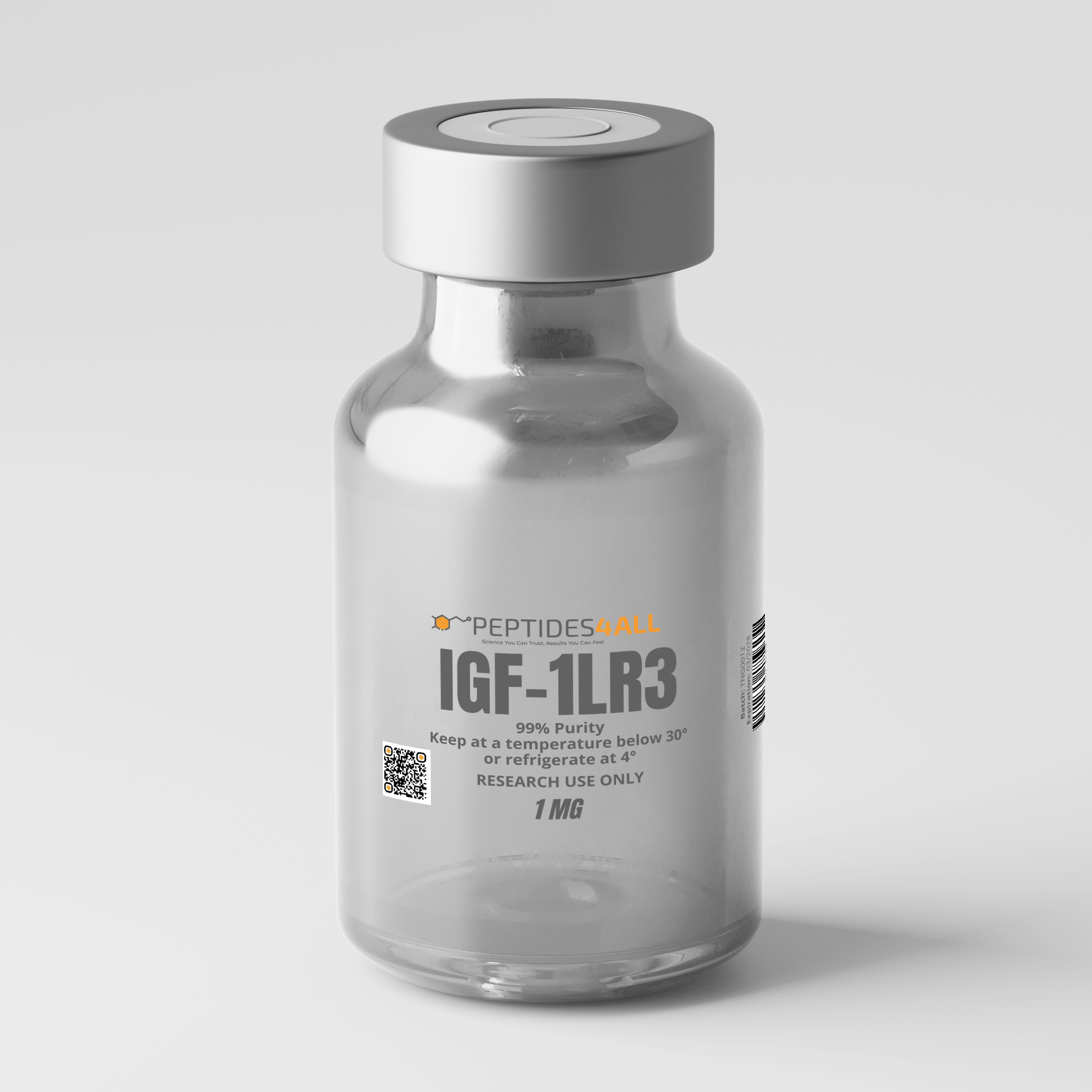PEPTIDES4ALL IGF-1 LR3 – Long-Acting IGF-1 Analogue for Regenerative & Metabolic Research
PEPTIDES4ALL IGF-1 LR3 represents an advanced analogue of Insulin-Like Growth Factor-1 (IGF-1), meticulously engineered to enhance the duration and magnitude of its biological activity. As a synthetic modified form of native IGF-1, this peptide features a long arginine substitution at position 3 (Long Arg3) that significantly reduces its affinity for IGF binding proteins (IGFBPs) — the natural regulators that limit IGF-1’s availability in circulation. By decreasing this binding, IGF-1 LR3 remains biologically active for a much longer period, enabling sustained receptor activation and a broader window for studying its anabolic and metabolic functions.
In cellular and physiological research, IGF-1 LR3 plays a pivotal role in exploring the growth, repair, and differentiation mechanisms that govern muscle, bone, and connective tissue. Acting primarily through the PI3K/Akt/mTOR signaling cascade, it promotes protein synthesis, cell proliferation, and nutrient uptake, while counteracting myostatin-mediated inhibition of muscle growth. These effects make it an indispensable model for studying muscle hypertrophy, regenerative medicine, and metabolic homeostasis.
Beyond its anabolic properties, IGF-1 LR3 is being investigated for its impact on fat metabolism, insulin sensitivity, and tissue repair. By influencing energy utilization and cellular recovery pathways, it serves as a crucial link between growth signaling and metabolic regulation, offering new avenues of exploration in anti-aging, rehabilitation, and performance research.
With its enhanced bioavailability, prolonged half-life, and high-purity lyophilized formulation, PEPTIDES4ALL IGF-1 LR3 provides researchers with a consistent, reliable foundation for advancing studies in regenerative biology, endocrinology, and cellular adaptation.
Scientific Evidence & Research Findings
-
Enhanced Muscle Growth & Protein Synthesis – IGF-1 activates the PI3K/Akt/mTOR pathway in muscle, boosting protein synthesis, inhibiting atrophy factors, and suppressing myostatin signaling. https://www.mdpi.com/2073-4409/9/9/1970
-
Counteracts Myostatin’s Inhibitory Effects – Research shows that IGF-1/Akt signaling can oppose myostatin and Smad pathways that normally suppress muscle growth. https://www.mdpi.com/2073-4409/9/9/1970
-
Improved Half-Life & Bioavailability – Because IGF-1 LR3 has reduced affinity for IGFBPs, it stays active longer than native IGF-1, enabling sustained receptor activation.
-
Metabolic & Fat Regulation Effects – Some evidence suggests that IGF signaling modulates muscle metabolism and fat handling through interactions with myostatin and energy pathways. https://translational-medicine.biomedcentral.com/articles/10.1186/s12967-014-0365-0
-
Support for Tissue Repair & Regeneration – Through enhancing cellular proliferation, nutrient uptake, and growth signaling, IGF-1 LR3 may help in recovery, connective tissue support, and general anabolic repair.
Key Research Benefits & Applications
-
Prolonged Anabolic Signaling: The Long Arg³ substitution in IGF-1 LR3 extends receptor activation by reducing binding to IGF-binding proteins (IGFBPs), allowing for sustained anabolic and metabolic activity in research models.
-
Muscle Growth & Regeneration: Potently stimulates myoblast proliferation, protein synthesis, and tissue regeneration through the PI3K/Akt/mTOR signaling pathway, promoting lean mass development and recovery from injury or atrophy.
-
Myostatin Antagonism & Muscle Preservation: Counteracts myostatin and Smad-mediated inhibition, supporting continuous muscle growth and preventing catabolic degradation.
-
Metabolic Regulation & Fat Utilization: Enhances insulin sensitivity, glucose uptake, and lipid metabolism, providing a model for studying energy balance and metabolic optimization.
-
Tissue Repair & Connective-Tissue Support: Facilitates cellular proliferation and nutrient absorption in muscle, tendon, and connective tissues, aiding recovery and regeneration in post-trauma or stress conditions.
-
Applications in Regenerative & Endocrine Research: Serves as a versatile tool for exploring growth signaling, metabolic health, and anti-aging mechanisms, bridging molecular biology with regenerative and performance research.
Presentation & Handling
- Form: Supplied as lyophilized peptide in sterile vial.
- Reconstitution: Use bacteriostatic water or 2% procaine; swirl gently (do not shake vigorously).
- Storage: Store at –20 °C, protected from light and moisture. After reconstitution, use according to research protocols and handle under sterile conditions.
Intended Use
For research purposes only. Must be handled in accordance with institutional protocols and ethical guidelines.
